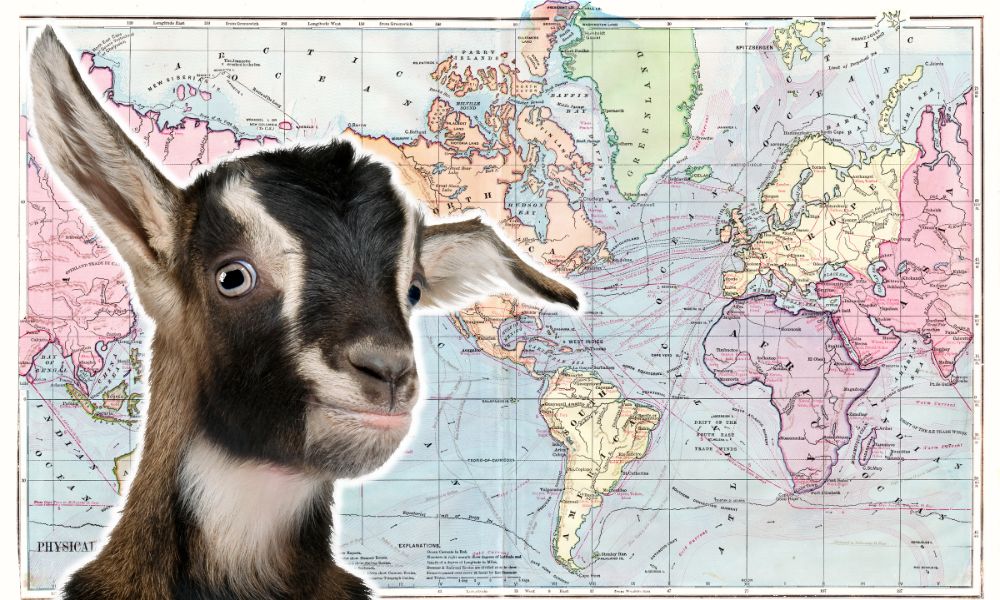Of course, there is both a wild and a domestic goat population, and this number accounts for both groups.
Naturally, domestic goats far outweigh wild goats and their population has grown exponentially since industrial farming.
There is a fascinating distribution of goats in the world both in terms of wild populations and domestic populations.

Which countries have the most goats?
The vast majority of the goat population- around 90%- is found in developing nations.
Goats are a great source of milk and meat for people who still rely on subsistence farming or simply cheaper meat.
It’s quite staggering to think, if there are 1 billion goats in the world, around 900 million of those live in developing nations.
That said, the single country with the highest number of goats is China.
In 2010, 45% of the world’s goat population was found in China.
China is an extremely large country with a massive human population, too, so one could say that parts of it are developing and parts of it are developed.
Goat farming in China is mostly industrial farming, rather than small family farms.
China is followed by Pakistan, India and Bangladesh for highest number.
The Indian subcontinent has a very long history of goat farming and rearing, and so there is a great distribution of goats in this region.
Per capita, Sudan consumes more goat than any other country in the world, at around 8.6 pounds of goat per person every year.
Sudan is a developing nation.
More developed and industrialized nations have, over the course of the last several centuries, moved away from goat farming to much larger scale cattle farming.
Cows produce a great deal more milk and more popular meat, though goat’s milk is still favored for a number of gourmet products like cheese.
Where did goats come from?
Goats were domesticated long before humans had any kind of writing system or recorded history.
Therefore, we cannot say with any certainty how long exactly humans have been rearing goats.
The agricultural revolution occurred between 9000 and 11,000 years ago.
Humans began raising animals rather than hunting them, and growing food rather than gathering it.
We can gather this from archaeological evidence, as our oldest evidence of agriculture in the archaeological record is about 11,000 years old.
These pieces of evidence come from the Near and Middle East.
The earliest evidence comes from western Iran, and we also have extensive evidence of goat herding in Egypt and Turkey.
We can see evidence that male goats were penned in, as the remains we find suggest they were selectively killed at a young age.
This indicates they were kept in pens and not hunted from the wild.
Sumer, the oldest human civilization of which we have evidence, is now modern-day Iraq, and animal herding was a huge part of life for Sumerians.
Goats were no doubt extensively farmed in Sumer.
Goats were not found in the Americas until they were introduced by European settlers from the 15th Century onwards.
The same is true of Australia.
Goats may even have been one of the first animals that humans domesticated, beside dogs.
Goats are relatively docile and are not especially frightened of people.
They made an obvious choice for people to domesticate, then.
They produced both good milk and meat, and even horns could be used to make a great variety of tools or decorative objects.
Also, their skins could be fashioned into clothes and furniture.
Ancient humans had to make use of absolutely every resource available to them, and so a goat with many uses was a great choice for domestication.
It’s fascinating to consider the process of thought which these ancient communities must have gone through.
They had none of the knowledge we have now about temperament, behavior, and everything else we now take for granted about animals.
They had to find out for themselves.
Goats, then, make a lot of sense.
They’re quite small and easy to restrain as compared to, say, pigs.
Wild pigs would be largely unrecognizable to us now, whereas goats probably haven’t changed all that much over the centuries.
Goats are docile and at worst they will headbutt you and you’ll get a bruise if they have horns.
A wild pig could tear out a chunk of your leg with its tusks if you give it half a chance.
All of this comes together to suggest that goats are perhaps the earliest domestic farm animal reared by humans.
It’s understandable, then, that even though the west and most developed countries farm a lot more cows than they do goats, that there is still a very high goat population in the world.
Goats, then, are everywhere. Since the deepest remnants of historical time goats have been humankind’s companions providing them with milk, meat and skins.
As of today, with a population of around a billion goats, it doesn’t look like they’ll be going anywhere anytime soon.
To this day they are a staple of farming in developing country’s and of gourmet products around the world.
